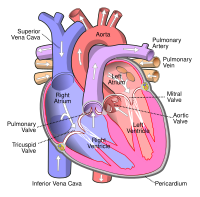
Photo from wikipedia
Background The anatomy and physiology of venous drainage in the reversed flow vascular pedicle is controversial and there have been few well‐designed, controlled studies to effectively evaluate the physiology. We… Click to show full abstract
Background The anatomy and physiology of venous drainage in the reversed flow vascular pedicle is controversial and there have been few well‐designed, controlled studies to effectively evaluate the physiology. We evaluated the available evidence for venous drainage to synthesize the conclusions of these studies, and to identify areas in need of further research. Methods Electronic databases were searched for articles published from January 1, 1950 to November 1, 2017. A total of 316 citations were screened for inclusion. Fifty articles met inclusion criteria and underwent review, yielding 12 articles for final data analysis. Three principal study types were found: human cadaveric (7), animal (3), human clinical (1), and mixed (1). Results We identified two main theories regarding the mechanism of venous drainage in reverse flow flaps. The “avalvular bypass” theory is based on the findings of intact valves of the venae comitantes, and venous outflow through the crossover pattern of the communicating branches and bypass pattern of the collateral branches. Alternatively, the “valvular incompetence” theory implies that pedicle dissection, proximal ligation, and insetting of the flap cause physiologic changes, such as increased venous pressure, denervation, and simultaneous proximal and distal filling, which together result in valvular insufficiency. Conclusion The mechanism by which retrograde venous outflow occurs in reverse flow flaps remains controversial. Nonetheless, a few well‐designed studies have contributed to the understanding of venous anatomy and outflow. Most likely, the true mechanism is based on venous outflow that occurs via the “avalvular bypass” route initially and the “valvular incompetence” route later.
Journal Title: Journal of Reconstructive Microsurgery
Year Published: 2019
Link to full text (if available)
Share on Social Media: Sign Up to like & get
recommendations!